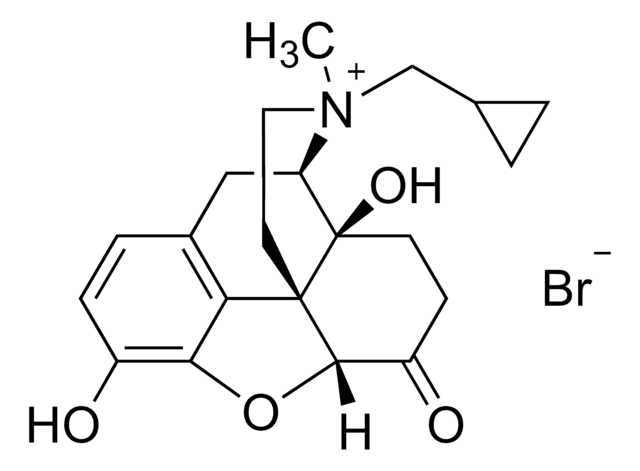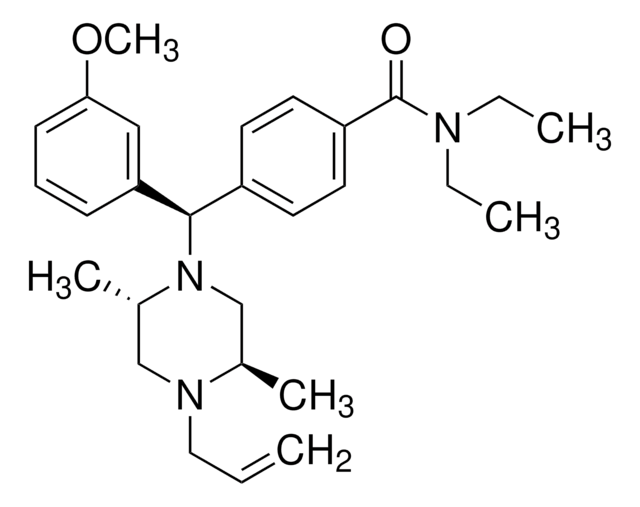推荐产品
化驗
≥97% (HPLC)
儲存溫度
−20°C
SMILES 字串
CC(O)=O.C[C@@H](NC(=O)[C@@H](N)Cc1ccc(O)cc1)C(=O)NCC(=O)N(C)[C@@H](Cc2ccccc2)C(=O)NCCO
InChI
1S/C26H35N5O6.C2H4O2/c1-17(30-25(36)21(27)14-19-8-10-20(33)11-9-19)24(35)29-16-23(34)31(2)22(26(37)28-12-13-32)15-18-6-4-3-5-7-18;1-2(3)4/h3-11,17,21-22,32-33H,12-16,27H2,1-2H3,(H,28,37)(H,29,35)(H,30,36);1H3,(H,3,4)/t17-,21+,22+;/m1./s1
InChI 密鑰
XZZYKCKUDLGXJA-NJUGUJQKSA-N
基因資訊
human ... OPRM1(4988)
mouse ... OPRM1(18390)
rat ... OPRM1(25601)
正在寻找类似产品? 访问 产品对比指南
Amino Acid Sequence
Tyr-Ala-Gly-Nme-Phe-Gly-ol
一般說明
[D-Ala2, N-Me-Phe4, Gly5-ol]-Enkephalin acetate salt or DAMGO is a full agonist of the μ-opioid receptor. μ-opioid receptor is encoded by the OPRM1 gene, which has a predominant expression in reward-processing areas of brain. It acts as a receptor for endogenous opioids such as β-endorphin, encephalin, as well as foreign opioids such as morphine, heroin, and methadone.
應用
[D-Ala2, N-Me-Phe4, Gly5-ol]-Enkephalin acetate salt or DAMGO has been used:
- for use as a positive control in the assay of G-protein activation with μ-opioid receptor, to assay the inhibition of cAMP inhibition by DAMGO
- for the determination of the suppression of contraction by opioid receptors
- to determine whether the peripheral application of DAMGO suppresses the hypertonic saline (HS)-induced masseter nociception in slightly anaesthetized rats
生化/生理作用
Enkephalin analog that is a selective agonist at μ-opioid receptors.
包裝
Bottomless glass bottle. Contents are inside inserted fused cone.
儲存類別代碼
11 - Combustible Solids
水污染物質分類(WGK)
WGK 3
閃點(°F)
Not applicable
閃點(°C)
Not applicable
個人防護裝備
Eyeshields, Gloves, type N95 (US)
其他客户在看
Frank J Meye et al.
The Journal of neuroscience : the official journal of the Society for Neuroscience, 32(46), 16120-16128 (2012-11-16)
μ-Opioid receptors (MORs) in the ventral tegmental area (VTA) are pivotally involved in addictive behavior. While MORs are typically activated by opioids, they can also become constitutively active in the absence of any agonist. In the current study, we present
Javier Llorente et al.
The European journal of neuroscience, 36(12), 3636-3642 (2012-09-26)
There is considerable controversy over whether μ-opioid receptor (MOPr) desensitization is homologous or heterologous and over the mechanisms underlying such desensitization. In different cell types MOPr desensitization has been reported to involve receptor phosphorylation by various kinases, including G-protein-coupled receptor
Raza Qazi et al.
Nature biomedical engineering, 3(8), 655-669 (2019-08-07)
Both in vivo neuropharmacology and optogenetic stimulation can be used to decode neural circuitry, and can provide therapeutic strategies for brain disorders. However, current neuronal interfaces hinder long-term studies in awake and freely behaving animals, as they are limited in
Ken W K Lee et al.
Journal of psychiatry & neuroscience : JPN, 40(1), 38-45 (2014-10-01)
Preference for fatty foods is a risk factor for obesity. It is a complex behaviour that involves the brain reward system and is regulated by genetic and environmental factors, such as the opioid receptor mu-1 gene (OPRM1) and prenatal exposure
B Driessen et al.
British journal of pharmacology, 108(2), 443-447 (1993-02-01)
1. Effects of opioid agonists on the purinergic and adrenergic components of neurogenic contractions and in some experiments on transmitter overflow were studied in the mouse isolated vas deferens. 2. When the vas deferens was stimulated every 2 min by
我们的科学家团队拥有各种研究领域经验,包括生命科学、材料科学、化学合成、色谱、分析及许多其他领域.
联系技术服务部门




![[D-Ala2, D-Leu5]-脑啡肽 乙酸盐 ≥95% (HPLC)](/deepweb/assets/sigmaaldrich/product/structures/934/176/d990e568-42df-43e9-a231-da7a3d9d7687/640/d990e568-42df-43e9-a231-da7a3d9d7687.png)
![[D-Pen2,5]-Enkephalin hydrate ≥95% (HPLC)](/deepweb/assets/sigmaaldrich/product/structures/184/136/1e0e1352-7665-406c-b51c-9a4fd9474b9a/640/1e0e1352-7665-406c-b51c-9a4fd9474b9a.png)




![[D-Ala2]-Leucine enkephalin ≥97% (HPLC)](/deepweb/assets/sigmaaldrich/product/structures/205/481/4fd123c0-14c7-4f90-8bdc-9e54a4bea7f1/640/4fd123c0-14c7-4f90-8bdc-9e54a4bea7f1.png)


